Prodoxidae
The yucca moth family
Olle Pellmyr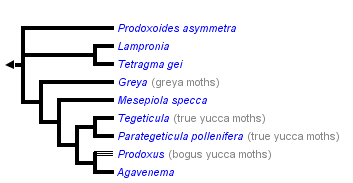


This tree diagram shows the relationships between several groups of organisms.
The root of the current tree connects the organisms featured in this tree to their containing group and the rest of the Tree of Life. The basal branching point in the tree represents the ancestor of the other groups in the tree. This ancestor diversified over time into several descendent subgroups, which are represented as internal nodes and terminal taxa to the right.

You can click on the root to travel down the Tree of Life all the way to the root of all Life, and you can click on the names of descendent subgroups to travel up the Tree of Life all the way to individual species.
For more information on ToL tree formatting, please see Interpreting the Tree or Classification. To learn more about phylogenetic trees, please visit our Phylogenetic Biology pages.
close boxTree compiled from Nielsen & Davis (1985) and Brown et al. (1994)
Introduction
The Prodoxidae is commonly known as the yucca moth family, and it contains some of the icons of coevolution. Small to medium in size, they are among the oldest of all moths. Fewer than 100 species have been described, but ongoing studies have uncovered a great number of species yet to be described.
Most prodoxid species fly during the day, but a few were among the very first moths that evolved a nocturnal habit. Most species have highly specific food habits, in that their larvae only eat specific parts of one or a few closely related plant species. If you want to find one of these moths, the easiest way is to search on its host plant because they spend most of their short lives on or around it. For example, if you want to see a yucca moth you can find them resting inside the flowers during the day. And if you come back after dusk with a red flashlight, you can see them in action on the flowers.
Members of the Prodoxidae have been of great importance to the study of relationships between insects and plants ever since Darwin. Charles Riley's 1872 discovery that yucca moths are tied in an obligate pollination/herbivory relationship with their hosts quickly turned them into one of the textbook cases of coevolution. Since then, yucca moths and greya moths have come to the fore in exploring questions about host shifts and their role in insect speciation, the evolution of insect pollination, and the evolution of cooperation between species.
If you'd like to learn more about the yucca moths and their relatives, use the phylogenetic tree to explore the systematics, ecology, and behavior of the different genera.

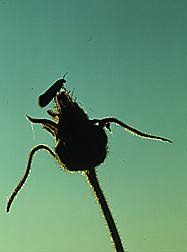
Characteristics

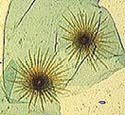
Signa of an undescribed species in the Tegeticula yuccasella complex
The monophyly of Prodoxidae is well supported by:
- a pair of stellate signa in the corpus bursae (modified or lost in some derived taxa).
- a rounded sternum VII in the female
- a triangular tergum VII in the female
Additional morphological traits that, in different combinations, distinguish Prodoxidae from other incurvarioid families include: antennae < 0.6 times length of forewing; forewing normally without metallic lustre; male valva either with an unstalked pectinifer or a pollex; ovipositor laterally compressed (Nielsen 1982, Nielsen & Davis 1985).
Life habits of immature stages
Eggs of all prodoxids are laid inside plant tissue. Larvae feed in stems, twigs, buds, seeds or vegetative parts of developing fruits, or in spun-together leaves (Nielsen & Davis 1985, Davis 1987, Davis et al. 1992). There is a trend toward increasing endophagy throughout all immature stages concurrent with the radiation into semi-arid and arid habitats in the more derived genera. Members of basal genera, such as Lampronia, mine inside host tissue, and typically cut out a leaf-case that serves as shelter during the last larval instars and as a pupation site. Members of Mesepiola, Tegeticula and Parategeticula complete larval development inside host tissue, but pupate in soil, whereas Prodoxus (including Agavenema) complete both larval and pupal stages inside the host and emerge as adults.

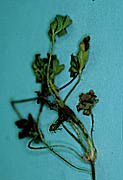
Lithophragma plant with pupal remains of Greya politella extruding from folded leaf.
Geographic distribution
Prodoxidae is primarily a family of the Northern hemisphere, with the monobasic Prodoxoides being the only Southern hemisphere representative. Lampronia is holarctic in distribution, and its sister group Tetragma confined to northwestern United States. Basal members of Greya occur in humid portions of east Asia and western North America (Davis et al. 1992, Kozlov 1996), with a major subsequent radiation into semiarid portions of the North American west. All other genera (Mesepiola, Tegeticula, Parategeticula, and Prodoxus) occur primarily in the North American deserts, with some secondary invasions of more humid habitats.
Discussion of Phylogenetic Relationships
Prodoxidae was delineated in 1982 as one of six monophyletic families in a realignment of the Incurvarioidea (Nielsen 1982). The subfamily Prodoxinae was the subject of two early revisions (Davis 1967, Frack 1982), but the family delineation marked a starting point for phylogenetic studies at different hierarchical levels based on morphological and molecular data (Nielsen & Davis 1985, Wagner & Powell 1988, Davis et al 1992, Brown et al. 1994a, 1994b, Pellmyr et al. 1996a,b). This unusual degree of attention has been generated by its utility as a model system in ecological and evolutionary studies (Thompson 1987, Addicott et al 1990, Powell 1992, Pellmyr & Huth 1994, Thompson 1994, Addicott 1996, Pellmyr et al 1996, Brown et al 1997).
There is substantial agreement on relationships among the constituent genera. The relative position of Prodoxides and Lampronia+Tetragma is unclear, but its resolution will be important to determine the geographic origin of the family (see Geographic distribution). The aberrant genus Tridentaforma, which shares apomorphic traits with Prodoxidae and Adelidae, was included in the basal grade by Nielsen & Davis (1985), but molecular data removed it from the family and instead supported adelid affinities (Brown et al. 1994a). These genera generally have historically been assigned as a subfamily Lamproniinae, but they represent a non-monophyletic grade.
The remaining genera share the synapomorphy of primary arms of the metathoracic furca being fused with the secondary arms of the furcasternum (Davis et al. 1992:21). The positions of Greya and Mesepiola are very robust, whereas the radiation of the yucca moths (s.l.) was quite rapid and the exact topology remains uncertain (Brown et al. 1994b). The genus Agavenema was nested within Prodoxus in a recent molecular phylogeny using a limited number of taxa (Brown et al 1994b); if corroborated by further study, this genus should be subsumed to create a monophyletic Prodoxus.
References
Addicott, J.F. 1996. Cheaters in yucca/moth mutualism. Nature 380:114-115.
Addicott, J.F., J. Bronstein, & F. Kjellberg. 1990. Evolution of mutualistic life-cycles: yucca moths and fig wasps. Pp. 143-161 in F. Gilbert, ed. Genetics, evolution, and coordination of insect life cycles. Springer, London.
Brown, J.M., O. Pellmyr, J.N. Thompson & R.G. Harrison. 1994a. Phylogeny of Greya (Lepidoptera: Prodoxidae), based on nucleotide sequence variation in mitochondrial cytochriome oxidase I and II: congruence with morphological data. Mol. Biol. Evol. 11:128-141.
Brown, J.M., O. Pellmyr, J.N. Thompson & R.G. Harrison. 1994b. Mitochondrial DNA phylogeny of the Prodoxidae (Lepidoptera: Incurvarioidea) indicates a rapid ecological diversification of the yucca moths. Ann. Entom. Soc. Amer. 87:795-802.
Brown, J., J. Leebens-Mack, O. Pellmyr & J.N. Thompson. 1997. Phylogeography and host association in a pollinating seed parasite, Greya politella (Lepidoptera, Prodoxidae). Molecular Ecology, in press.
Davis, D.R. 1967. A revision of the moths of the subfamily Prodoxinae (Lepidoptera: Incurvariidae). U.S. Nat. Hist. Mus., Bull. 255:1-170.
Davis, D.R. 1987. Incurvarioidea. In: F. Stehr (ed.) An introduction to the immature insects of North America. Kendall-Hunt, Dubuque, IA.
Davis, D.R., O. Pellmyr & J.N. Thompson. 1992. Biology and systematics of Greya Busck and Tetragma n. gen. (Lepidoptera: Prodoxidae). Smiths. Contrib. Zool. 524:1-88.
Frack, D.C. 1982. A systematic study of prodoxine moths (Adelidae: Prodoxinae) and their hosts (Agavaceae), with descriptions of the subfamilies of Adelidae (s. lat.). M.S. thesis, California State Polytechnic University, Pomona, CA.
Nielsen, E.S. 1982. Incurvariidae and Prodoxidae from the Himalayan area (Lepidoptera: Incurvarioidea). Ins. Matsum. 26:187-200.
Nielsen, E.S. & D.R. Davis. 1985. The first southern hemisphere prodoxid and the phylogeny of the Incurvarioidea (Lepidoptera). Syst. Entom. 10:307-322.
Pellmyr, O. & C.J. Huth. 1994. Evolutionary stability of mutualism between yuccas and yucca moths. Nature 372:257-260.
Pellmyr, O., J. Leebens-Mack & C.J. Huth. 1996a. Non-mutualistic yucca moths and their evolutionary consequences. Nature 380:155-156.
Pellmyr, O., J.N. Thompson, J. Brown & R.G. Harrison. 1996b. Evolution of pollination and mutualism in the yucca moth lineage. Amer. Nat. 148:827-847.
Powell, J.A. 1984. Biological interrelationships of moths and Yucca schottii. Univ. Calif. Publ. Entomol. 100:1-93.
Powell, J.A. 1992. Interrelationships of yuccas and yucca moths. TREE 7:10-15.
Powell, J.A. and R.A. Mackie. 1966. Biological interrelationships of moths and Yucca whipplei. Univ. Calif. Publ. Entomol. 42:1-59.
Thompson, J.N. 1987. Variance in number of eggs per patch: oviposition behaviour and population dispersion in a seed parasitic moth. Ecol. Entom. 12:311-320.
Thompson, J.N. 1994. The Coevolutionary Process. University of Chicago Press, Chicago
Wagner, D.L. & J.A. Powell. 1988. A new Prodoxus from Yucca baccata: first report of a leaf-mining prodoxine (Lepidoptera: Prodoxidae). Ann. Entom. Soc. Amer. 81:547-553.
Title Illustrations

| Scientific Name | Tegeticula yuccasella and Yucca filamentosa |
|---|---|
| Specimen Condition | Live Specimen |
| Behavior | Tegeticula yuccasella female in the process of actively pollinating a Yucca filamentosa flower. |
| Sex | Female |
| Image Use |
 This media file is licensed under the Creative Commons Attribution-NonCommercial License - Version 3.0. This media file is licensed under the Creative Commons Attribution-NonCommercial License - Version 3.0.
|
| Copyright |
© 1996

|
| Scientific Name | Greya mitellae, Mitella stauropetala |
|---|---|
| Specimen Condition | Live Specimen |
| Behavior | Greya mitellae drinking nectar and accidentally pollinating its host plant, Mitella stauropetala. |
| Image Use |
 This media file is licensed under the Creative Commons Attribution-NonCommercial License - Version 3.0. This media file is licensed under the Creative Commons Attribution-NonCommercial License - Version 3.0.
|
| Copyright |
© 1996

|
About This Page

University of Idaho, Moscow, Idaho, USA
Correspondence regarding this page should be directed to Olle Pellmyr at
Page copyright © 1996
 Page: Tree of Life
Prodoxidae. The yucca moth family.
Authored by
Olle Pellmyr.
The TEXT of this page is licensed under the
Creative Commons Attribution-NonCommercial License - Version 3.0. Note that images and other media
featured on this page are each governed by their own license, and they may or may not be available
for reuse. Click on an image or a media link to access the media data window, which provides the
relevant licensing information. For the general terms and conditions of ToL material reuse and
redistribution, please see the Tree of Life Copyright
Policies.
Page: Tree of Life
Prodoxidae. The yucca moth family.
Authored by
Olle Pellmyr.
The TEXT of this page is licensed under the
Creative Commons Attribution-NonCommercial License - Version 3.0. Note that images and other media
featured on this page are each governed by their own license, and they may or may not be available
for reuse. Click on an image or a media link to access the media data window, which provides the
relevant licensing information. For the general terms and conditions of ToL material reuse and
redistribution, please see the Tree of Life Copyright
Policies.
- First online 13 January 1997
Citing this page:
Pellmyr, Olle. 1997. Prodoxidae. The yucca moth family. Version 13 January 1997 (under construction). http://tolweb.org/Prodoxidae/11872/1997.01.13 in The Tree of Life Web Project, http://tolweb.org/




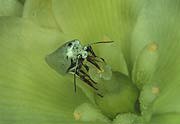




 Go to quick links
Go to quick search
Go to navigation for this section of the ToL site
Go to detailed links for the ToL site
Go to quick links
Go to quick search
Go to navigation for this section of the ToL site
Go to detailed links for the ToL site